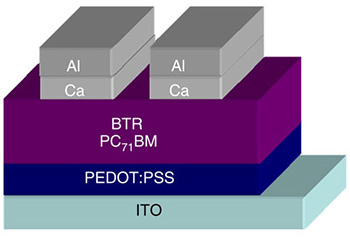
Schematic of BTR-based organic photovoltaic device. Credit: Nat. Commun., doi: 10.1038/ncomms7013
Despite being mechanically flexible and inexpensive to produce, printed organic photovoltaics (OPVs) are not as widespread as silicon-based PVs because of their comparatively lower power conversion efficiency (PCE). However, a new nematic liquid-crystal material could greatly increase performance for printed OPVs (Nat. Commun., doi: 10.1038/ncomms7013), bringing affordable, mass-produced and environmentally friendly solar cells one step closer to reality.
An international team of researchers led by David Jones at the University of Melbourne, Australia, demonstrated that their printable benzodithiophene terthiophen rhodanin (BTR)-based nematic crystalline material could boost OPV performance to levels similar to polymer-based PVs (e.g., silicon). When tested under AM 1.5G solar irradiation, the BTR-based OPVs reached a maximum PCE of 9.3 percent—up from 8 percent for other OPVs and close to the international OPV benchmark of 10 percent.
Solar cells made with BTR also achieved a high fill factor (FF) of 77 percent, suggesting that BTR-based OPVs can work efficiently at a wide range of thicknesses (from 80 to 400 nm), which is particularly important for print manufacturing because it is difficult to control roll-to-roll printing of very thin films.
Lead author David Jones states in a press release that the team’s discovery “is a step forward for the wider commercialization of printed organic solar cells. But more than this, it could aid in the development of new materials with improved performance, such as LCD screens.”

